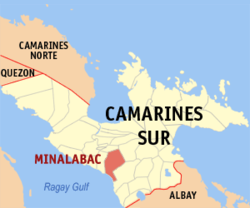Minalabac, Camarines Sur
| Minalabac | ||
|---|---|---|
| Municipality | ||

Municipal hall of Minalabac
|
||
|
||
 Map of Camarines Sur showing the location of Minalabac |
||
| Location within the Philippines | ||
| Coordinates: 13°34′N 123°11′E / 13.57°N 123.18°ECoordinates: 13°34′N 123°11′E / 13.57°N 123.18°E | ||
| Country | Philippines | |
| Region | Bicol (Region V) | |
| Province | Camarines Sur | |
| District | 2nd district | |
| Barangays | 25 | |
| Government | ||
| • Mayor | Christopher "Jojo" Lizardo | |
| Area | ||
| • Total | 126.1 km2 (48.7 sq mi) | |
| Population (2015 census) | ||
| • Total | 52,390 | |
| • Density | 420/km2 (1,100/sq mi) | |
| Time zone | PST (UTC+8) | |
| ZIP code | 4414 | |
| IDD : area code | +63 (0)54 | |
| Income class | 3rd class; partially urban | |
Minalabac is a third class municipality in the province of Camarines Sur, Philippines. According to the 2015 census, it has a population of 52,390 people.
It is known for the so-called "Tumatarok ni San Felipe-Santiago" dance festival where young boys aged 10 to 12 years old performed the dance ritual.
Minalabac is politically subdivided into 25 barangays.
In the 2015 census, the population of Minalabac was 52,390 people, with a density of 420 inhabitants per square kilometre or 1,100 inhabitants per square mile.
Considered as one of the most colorful and interesting fiestas in the Bikol region, the Tumatarok Festival is celebrated every 11 May which is done in honor of their two patron saints, Sts. Philip and James. Main highlights of the festive occasion include the evening tide fluvial procession where colorful floating pagodas crowd along the banks of the Bikol River ; the religious dancing of little boys who are called here as the Tumatarok ni San Felipe-San Tiago or the Rice Planters of Sts. Philip and James. These little boys, ages 8 to 11, sing the traditional Bikol hymn to the two saints. Likewise, after the celebration of the mass the next morning, the ten tumatarok once again performed another ritual, this time a sacred dance, in the sanctuary of the Church. It was said that their dance was a prayer to God, thanking Him for blessing upon the coming rice planting season which then and even now is the main source of income to many Minalabacueños.
The dance component of Bicol religious ritual was retained in colonial times. On the feast of San Felipe and Santiago in May, in Minalabac, Camarines Sur, men carry the saint's images and estandartes of bamboo towers, while the children in costumes that change annually, dance the tuatarok (literally, "rice planters"), clicking their castanets and singing verses of praise to the twin patron saints and imploring their help for the officials and members of the community. Among the secular dances, the engano, a graceful sway, and the waltz step are of Spanish origin. Boys and girls dance Albay's inkoy-inkoy to three-part music, sagurang being its oldest Bicol version. The jota Bicolana is lively as the Spanish jotas
The town is not just famous for the dance festival but is likewise considered as the refuge of many distinguished political figures with their families during the outbreak of the World War II.
BALIUAG VIEJO Miraculous Saints - Saint Anthony De Padua
Two main summer beach destinations include the pebble beach in Bagolatao and sand beach in Hamoraon. The growing number of resorts offers amenities such as cottages, videoke, rest house, etc.
...
Wikipedia


